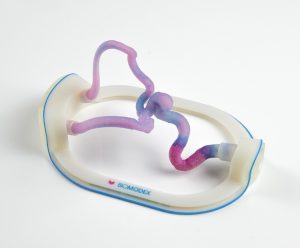3D printing is one of those technologies catalyzing change across myriad industries. It’s creating a platform for customized footwear and jewelry, enabling new business models for on-demand production of spare parts, and fueling light weighting initiatives for jet engines and cars.
Personalized medicine is another hot bed of 3D printing activity. The technology has already ushered in a new generation of custom prosthetics, surgical guides, and dental implants. Now, work is underway to leverage 3D printing in the pharmaceuticals space, as a mechanism to create new drug delivery vehicles as well as customized medications. According to research from Global Market Insights, the healthcare 3D printing market is well on its way to hitting $2.2 billion by 2024.

The 3D printing pharmaceuticals odyssey started back in 2015 when the Food and Drug Administration (FDA) gave its stamp of approval to Spritam, the first 3D printed prescription drug, released the following year by Aprecia Pharmaceuticals for treatment for epilepsy. The ZipDose 3D printing technology used creates a high-dose medication in a fast-dissolving form, making it more palatable for patients struggling to consume medication.
Beyond that initiative, 3D printing techniques are also facilitating the creation of pills that control release of active ingredients, helping patients stay in compliance. There are also technology experiments to output highly personalized 3D printed tablets with customized dosages of multiple medications. To that end, FabRx, a spin-off of the University College London’s School of Pharmacy, has developed Printlets, tablets produced with 3D printing technologies like Fused Deposition Modeling (FDM) and Stereolithography (SLA) to offer customized doses of medication. The industry sees potential for 3D printed pharmaceuticals as a way to reduce costs, promote small batch manufacturing, and create complex forms that combine multiple medications or deliver customized prescriptions for specific patients.
In addition to the production of actual pills, 3D printing technology has more recently found a role creating new types of oral delivery devices to promote more personalized drug therapies. Professors at ETH Zurich, in collaboration with researchers at the Institute of Bioengineering and Nanotechnology in Singapore and the University of Montreal in Canada, conducted a human study of 3D printed drug delivery mouth guards to gauge their performance compared to the traditional one-size-fits-all approach. And researchers from the Germany-based Institute of Integrative Nanosciences at IFW in Dresden are creating 3D printed so called “spermbots” as a mechanism to deliver drugs for treating cancerous tumors in female reproductive tracts.

Along with the flurry of innovation happening on the pharmaceutical front, 3D printing is making significant strides as a way to create surgical guides and training solutions for medical practitioners. In one such example, French company Biomodex, working in partnership with Dassault Systems’ 3DEXPERIENCE Lab, is leveraging advances in 3D printing technology and virtual simulation to fabricate life-like human organs used by medical students and physicians as part of their early training and for practicing medical procedures prior to live surgery.
We are just at the beginning of the next chapter in personalized medicine, but there’s little doubt that 3D printing will play a healthy role.
